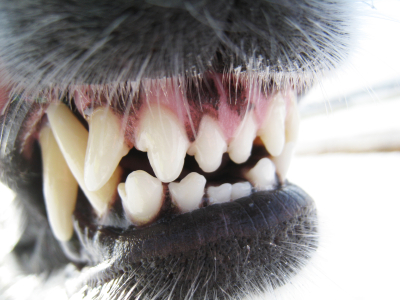 Periodontal disease has traditionally been one of the most common and most overlooked health conditions in our pets. What is periodontal disease? In practical terms, it is bleeding gums, sore teeth, bad breath, and in extreme cases, jaw bone infections. Many veterinarians think back to “doggy breath” and blood on chew toys of our childhood pets and wonder, how could we have thought this is normal? And yet, even today, many people don’t recognize that their pets’ teeth need regular care, just like ours do!
Periodontal disease has traditionally been one of the most common and most overlooked health conditions in our pets. What is periodontal disease? In practical terms, it is bleeding gums, sore teeth, bad breath, and in extreme cases, jaw bone infections. Many veterinarians think back to “doggy breath” and blood on chew toys of our childhood pets and wonder, how could we have thought this is normal? And yet, even today, many people don’t recognize that their pets’ teeth need regular care, just like ours do!
It’s important to bring your dogs and cats to their veterinarian to check their dental health. Bad teeth can lead to many problems beyond a case of foul dog/cat breath. The build up of plaque on the teeth can cause abscesses that are both uncomfortable and dangerous for pets. The danger lies in the infection entering the dog or cat’s blood stream and causing impaired blood flow to the heart, kidneys or brain.
How to Perform an At-Home Oral Check-up
Check your pets teeth by gently pulling up the lip and looking for the 7 signs as listed below. Be careful when performing this exam and stop immediately if the dog or cat exhibits pain or aggressive behavior. If the home exam is successful and any swelling or decay is visible, it is time for a trip to the veterinarian’s office. If you are unsure, play it safe and stop by your veterinarian’s office, anyhow.
Signs your pet may have a dental health issue
-
Visible swelling on the animal’s face.
-
Inflamed and/or red gums
-
Trouble eating or chewing on only one side of the mouth.
-
Pet may act like it is ill or run a fever.
-
Halitosis (bad breath)
-
Teeth that are a black or greenish color or have become loose
-
Tartar or Calculus (hard coating on teeth that is usually brown or yellow)
Good oral care is the best way to help pets maintain the shiny teeth and pink gums that represent good dental health. This can be accomplished by regular check-ups and incorporating preventative dental care measures.
At the time of a professional veterinarian cleaning, pets are given a light anesthesia, and plaque is removed with an ultrasonic cleaning tool, just like when you go to the dentist! The teeth are polished, this isn’t a cosmetic job! Polishing smoothes the enamel and removes microscopic irregularities that make it easier for plaque causing bacteria to attach. We do dental X-rays to evaluate what is going on below the gum line. If any decayed teeth are found, we call the owner, and make a health plan. Usually decayed teeth are removed the same day and antibiotics are given to fight the infection. There are also oral care products that can be included in water or food that help fight the plaque build-up on the teeth of dogs and cats.
Remember, it’s very important to protect your dog or cat with regular oral care. You can do this by having regular check-ups with your veterinarian, keeping an eye out for signs of infection and use products that help prevent plaque build-up on your pet’s teeth.
by Dr. Uri Burstyn, B.Sc., B.V.Sc. (Hons I)
Arbutus West Animal Clinic




